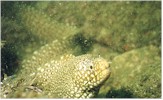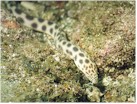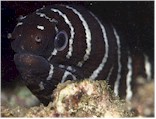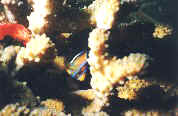 Moray eels are a small group of odd-shaped
fish. They are the eels most likely to be seen by divers and snorkelers because they
inhabit shallow depths from 5 feet, close to shore. Morays have snake-like bodies and
movements, but are actually fish. Approximately 110 different species have been identified
around the world. Of this number, divers and snorkelers in our area see only six species. Moray eels are a small group of odd-shaped
fish. They are the eels most likely to be seen by divers and snorkelers because they
inhabit shallow depths from 5 feet, close to shore. Morays have snake-like bodies and
movements, but are actually fish. Approximately 110 different species have been identified
around the world. Of this number, divers and snorkelers in our area see only six species.
 The three most frequent species
encountered are the jewel, green and the spotted snake eel. Normally, morays are shy,
retiring animals. They spend the day holed up in small crevices, caves, or under rocks.
They are nocturnal feeders and rarely emerge from their lairs in daylight hours unless
enticed by the scent of food. The three most frequent species
encountered are the jewel, green and the spotted snake eel. Normally, morays are shy,
retiring animals. They spend the day holed up in small crevices, caves, or under rocks.
They are nocturnal feeders and rarely emerge from their lairs in daylight hours unless
enticed by the scent of food.
 Moray eels are frequently seen poking
their heads partially out of a crevice with their mouths open. If you watch carefully, you
will notice the moray appears to be panting. It is actually inhaling water, passing it
through its gills and out the gill holes. It is this breathing technique that has earned
the moray eel its reputation as a dangerous sea creature. When the eel opens its mouth to
breathe, the fang-like teeth are automatically bared. Humans perceive the bared teeth as
threatening, but the docile moray doesn't plan on having you for lunch! Moray eels are frequently seen poking
their heads partially out of a crevice with their mouths open. If you watch carefully, you
will notice the moray appears to be panting. It is actually inhaling water, passing it
through its gills and out the gill holes. It is this breathing technique that has earned
the moray eel its reputation as a dangerous sea creature. When the eel opens its mouth to
breathe, the fang-like teeth are automatically bared. Humans perceive the bared teeth as
threatening, but the docile moray doesn't plan on having you for lunch!
 Their color and markings can easily
identify morays. Each Pacific moray is quite distinctive. The green moray (cover photo)
appears dark green. The zebra moray has white bands (stripes) on a reddish or dark brown
body. The jewel moray has chain-like rows or light yellow spots ringed by dark brown halos
on a gray body. A close relative, the spotted snake eel, has large black spots on its
body. It doesn't take long to learn to distinguish one species from another. Their color and markings can easily
identify morays. Each Pacific moray is quite distinctive. The green moray (cover photo)
appears dark green. The zebra moray has white bands (stripes) on a reddish or dark brown
body. The jewel moray has chain-like rows or light yellow spots ringed by dark brown halos
on a gray body. A close relative, the spotted snake eel, has large black spots on its
body. It doesn't take long to learn to distinguish one species from another.
Enjoy your
little sightseeing trips in my ocean here in Manzanillo, but please don't try to feed the
morays cheese or peas, or any other unnatural food source. It really gives them a tummy
ache! For more information on my marvelous Pacific Ocean creatures,
e-mail: motherocean@gomanzanillo.com |





